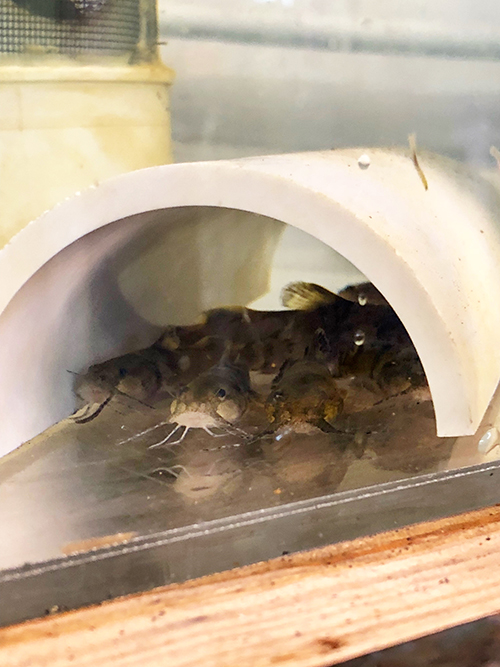MSU researchers build madtom catfish hotels for business of conserving imperiled species
Contact: Reagan Poston

STARKVILLE, Miss.—Mississippi State researchers are discovering that opening hotels—fish hotels—for ‘checking in’ on imperiled, hard-to-find aquatic species is a valuable business.
Built specifically for frecklebelly madtom catfish, MSU fisheries biologists are seeing that the new housing aids them in studying the freshwater species for more effective conservation strategies.
Averaging under four inches in length and native to river systems in Louisiana, Mississippi, Alabama, Georgia and Tennessee, small-bodied fish, like madtoms, are disproportionately at-risk relative to larger fish species. Their declining population, small size and nocturnal habits have made traditional methods of population monitoring neither efficient nor accurate.
“Previous research has shown that artificial shelters have been effective at luring madtoms inside, but we wanted to modify the design so that the hotels would monitor the fish too,” said Mike Colvin, fisheries biologist in the MSU Forest and Wildlife Research Center, who has partnered with the Mississippi Department of Wildlife, Fisheries and Parks and the U.S. Fish and Wildlife Service in these conservation efforts.
The researchers began successfully implanting passive integrated transponder (PIT) tags into a population of frecklebelly madtom at the Private John Allen National Fish Hatchery in Tupelo. These tags assign unique identification codes to each fish that are read through a radio-frequency identification, or RFID antenna. The implantation, while tricky on such small fish, had a very high success rate, with about 90 percent tag retention.
Each artificial shelter then was equipped with an RFID antenna to record and transmit the PIT tag number of each fish crossing the hotel threshold. Madtom, preferring cave-like enclosures over open water, began regularly swimming inside and giving researchers a clear picture of the habits, populations and routines of these cryptic fish.
Colvin, also an associate professor in the wildlife, fisheries and aquaculture department, described how this behavioral quirk benefits scientists.
“By putting the reader antenna on the hotel’s opening, we increase the likelihood of detecting these species simply by exploiting the madtom’s intrinsic behavior,” Colvin said. “We monitor how accurately the RFID-enabled hotels count the number of madtoms in the tank, as well as the frequency with which the fish maneuver in and out of the hotels.”
Now that these madtom hotels are open for madtom tenants, MSU researchers and conservation hatcheries will have a much better idea of how effectively stocking this species is for its recovery.
David Schumann, a former postdoctoral associate with the wildlife, fisheries and aquaculture department in the College of Forest Resources, worked as the study’s undergraduate coordinator and hopes to follow the research into the streams for field testing as the next step.
“Some adjustments have to be made as far as anchoring the shelters, but I have no doubt that the team assembled for this part of the project will continue on,” said Schumann, who now teaches at the University of Wisconsin-La Crosse. “This research highlights the unique challenges associated with conserving small, non-game species. Not all fish can be monitored in the same way, and the crux of this project tries to find a way to adapt our practices to work for even the most difficult-to-find species.”
“What we’ve seen so far has shown that collaborations can lead to some incredible products and innovations. The interest and work of undergraduate student Rick Campbell [of Tupelo], plus state and federal biologists providing funding and assistance, has made this study possible.
This research was published in Endangered Species Research journal and can be viewed here.
For more on the Department of Wildlife, Fisheries and Aquaculture, visit www.cfr.msstate.edu/wildlife. Information about the Forest and Wildlife Research Center can be found at www.fwrc.msstate.edu.
MSU is Mississippi’s leading university, available online at www.msstate.edu.